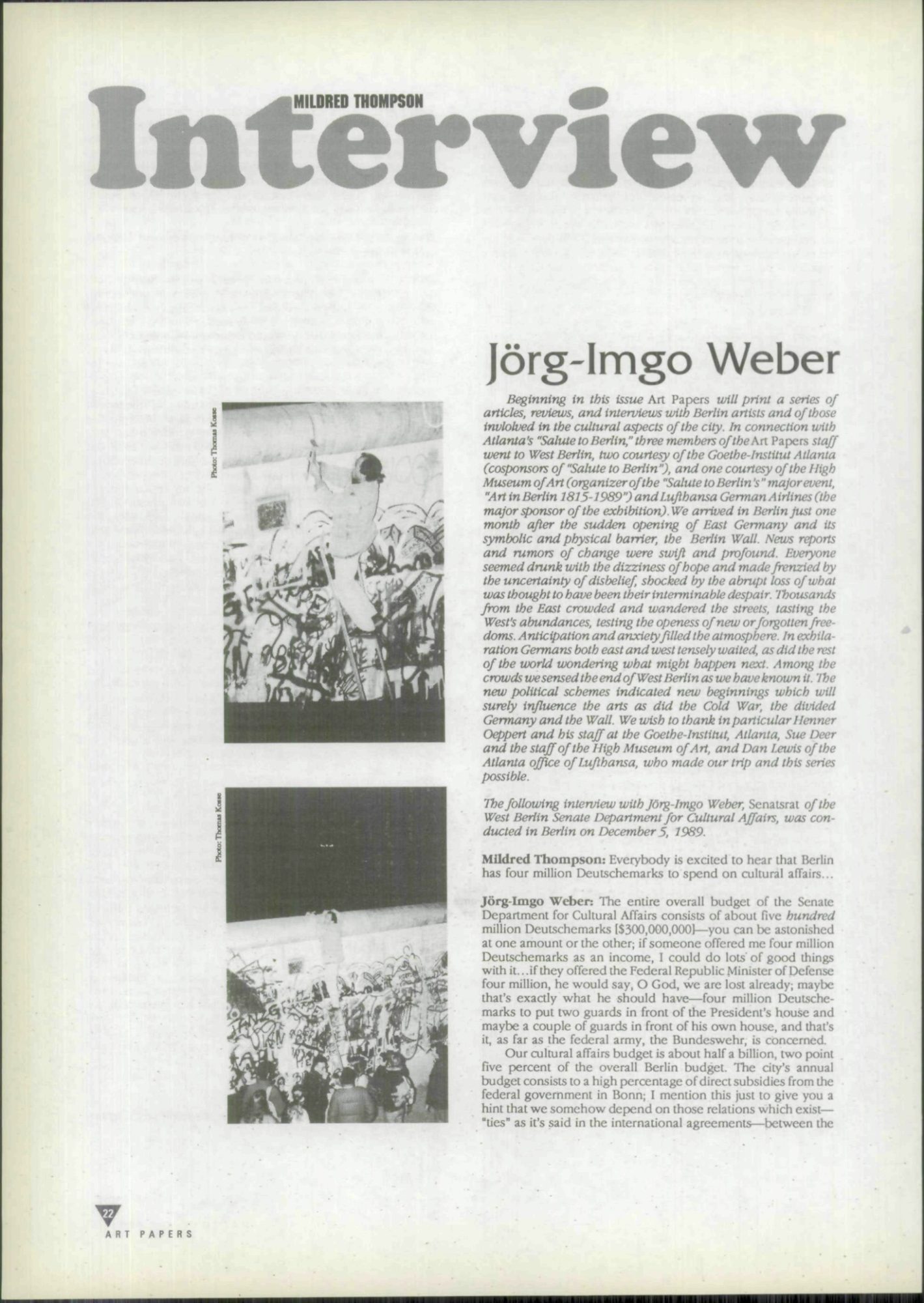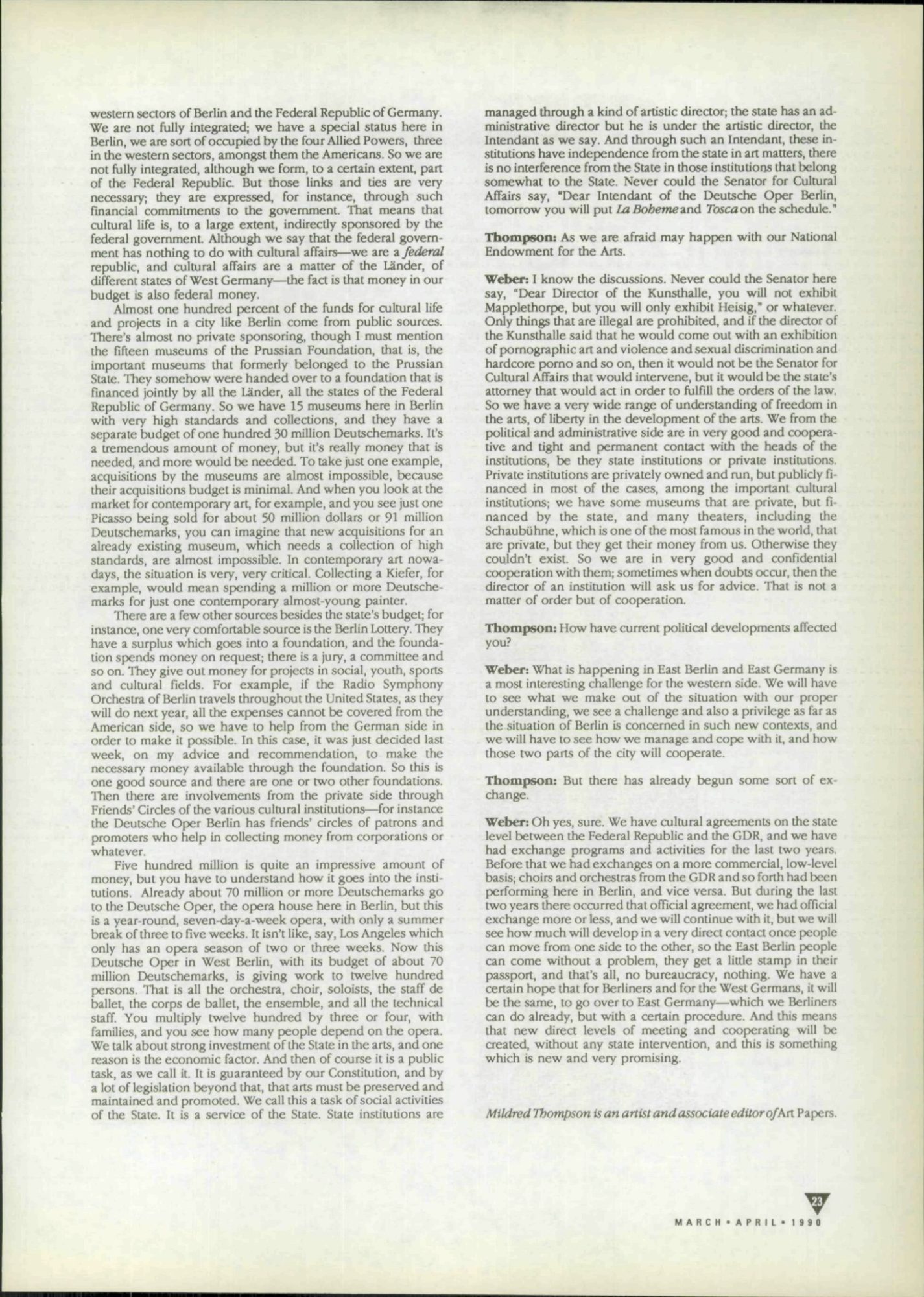Jörg-Imgo Weber
Share:
This interview was originally published in ART PAPERS March/April 1990, Vol. 14, issue 2.
Beginning in this issue Art Papers will print a series of articles, reviews, and interviews with Berlin artists and of those involved in the cultural aspects of the city. In connection with Atlanta’s “Salute to Berlin,” three members of the Art Papers staff went to West Berlin, two courtesy of the Goethe-Institut Atlanta (cosponsors of “Salute to Berlin”), and one courtesy of the High Museum of Art (organizer of the “Salute to Berlin’s” major event, “Art in Berlin 1815-1989”) Lufthansa German Airlines (the major sponsor of the exhibition). We arrived in Berlin just one month after the sudden opening of East Germany and its symbolic and physical barrier, the Berlin Wall. News reports and rumors of change were swift and profound. Everyone seemed drunk with the dizziness of hope and made frenzied by the uncertainty of disbelief, shocked by the abrupt loss of what was thought to have been their interminable despair. Thousands from the East crowded and wandered the streets, tasting the West’s abundances, testing the openess of new or forgotten freedoms. Anticipation and anxiety filled the atmosphere. In exhilaration Germans both east and west tensely waited, as did the rest of the world wondering what might happen next. Among the crowds we sensed the end of West Berlin as we have known it. The new political schemes indicated new beginnings which will surely influence the arts as did the Cold War, the divided Germany and the Wall. We wish to thank in particular Henner Oeppert and his staff at the Goethe-Institut, Atlanta, Sue Deer and the staff of the High Museum of Art, and Dan Lewis of the Atlanta office of Lufthansa, who made our trip and this series possible.
The following interview with Jörg-Imgo Weber, Senatsrat of the West Berlin Senate Department for Cultural Affairs, was conducted in Berlin on December 5, 1989.
Mildred Thompson: Everybody is excited to hear that Berlin has four million Deutschemarks to spend on cultural affairs…
Jörg-Imgo Weber: The entire overall budget of the Senate Department for Cultural Affairs consists of about five hundred million Deutschemarks [$300,000,000]—you can be astonished at one amount or the other; if someone offered me four million Deutschemarks as an income, I could do lots of good things with it… if they offered the Federal Republic Minister of Defense four million, he would say, O God, we are lost already; maybe that’s exactly what he should have—four million Deutschemarks to put two guards in front of the President’s house and maybe a couple of guards in front of his own house, and that’s it, as far as the federal army, the Bundeswehr, is concerned.
Our cultural affairs budget is about half a billion, two point five percent of the overall Berlin budget. The city’s annual budget consists to a high percentage of direct subsidies from the federal government in Bonn; I mention this just to give you a hint that we somehow depend on those relations which exist— “ties” as it’s said in the international agreements—between the western sectors of Berlin and the Federal Republic of Germany. We are not fully integrated; we have a special status here in Berlin, we are sort of occupied by the four Allied Powers, three in the western sectors, amongst them the Americans. So we are not fully integrated, although we form, to a certain extent, part of the Federal Republic. But those links and ties are very necessary; they are expressed, for instance, through such financial commitments to the government. That means that cultural life is, to a large extent, indirectly sponsored by the federal government. Although we say that the federal government has nothing to do with cultural affairs—we are a federal republic, and cultural affairs are a matter of the Lander, of different states of West Germany—the fact is that money in our budget is also federal money.
Almost one hundred percent of the funds for cultural life and projects in a city like Berlin come from public sources. There’s almost no private sponsoring, though I must mention the fifteen museums of the Prussian Foundation, that is, the important museums that formerly belonged to the Prussian State. They somehow were handed over to a foundation that is financed jointly by all the Länder, all the states of the Federal Republic of Germany. So we have 15 museums here in Berlin with very high standards and collections, and they have a separate budget of one hundred 30 million Deutschemarks. It’s a tremendous amount of money, but it’s really money that is needed, and more would be needed. To take just one example, acquisitions by the museums are almost impossible, because their acquisitions budget is minimal. And when you look at the market for contemporary art, for example, and you see just one Picasso being sold for about 50 million dollars or 91 million Deutschemarks, you can imagine that new acquisitions for an already existing museum, which needs a collection of high standards, are almost impossible. In contemporary art nowadays, the situation is very, very critical. Collecting a Kiefer, for example, would mean spending a million or more Deutschemarks for just one contemporary almost-young painter.
There are a few other sources besides the state’s budget; for instance, one very comfortable source is the Berlin Lottery. They have a surplus which goes into a foundation, and the foundation spends money on request; there is a jury, a committee and so on. They give out money for projects in social, youth, sports and cultural fields. For example, if the Radio Symphony Orchestra of Berlin travels throughout the United States, as they will do next year, all the expenses cannot be covered from the American side, so we have to help from the German side in order to make it possible. In this case, it was just decided last week, on my advice and recommendation, to make the necessary money available through the foundation. So this is one good source and there are one or two other foundations. Then there are involvements from the private side through Friends’ Circles of the various cultural institutions—for instance the Deutsche Oper Berlin has friends’ circles of patrons and promoters who help in collecting money from corporations or whatever.
Five hundred million is quite an impressive amount of money, but you have to understand how it goes into the institutions. Already about 70 million or more Deutschemarks go to the Deutsche Oper, the opera house here in Berlin, but this is a year-round, seven-day-a-week opera, with only a summer break of three to five weeks. It isn’t like, say, Los Angeles which only has an opera season of two or three weeks. Now this Deutsche Oper in West Berlin, with its budget of about 70 million Deutschemarks, is giving work to twelve hundred persons. That is all the orchestra, choir, soloists, the staff de ballet, the corps de ballet, the ensemble, and all the technical staff. You multiply twelve hundred by three or four, with families, and you see how many people depend on the opera. We talk about strong investment of the State in the arts, and one reason is the economic factor. And then of course it is a public task, as we call it. It is guaranteed by our Constitution, and by a lot of legislation beyond that, that arts must be preserved and maintained and promoted. We call this a task of social activities of the State. It is a service of the State. State institutions are managed through a kind of artistic director; the state has an administrative director but he is under the artistic director, the Intendant as we say. And through such an Intendant, these institutions have independence from the state in art matters, there is no interference from the State in those institutions that belong somewhat to the State. Never could the Senator for Cultural Affairs say, “Dear Intendant of the Deutsche Oper Berlin, tomorrow you will put La Boheme and Tosca on the schedule.”
Thompson: As we are afraid may happen with our National Endowment for the Arts.
Weber: I know the discussions. Never could the Senator here say, “Dear Director of the Kunsthalle, you will not exhibit Mapplethorpe, but you will only exhibit Heisig,” or whatever. Only things that are illegal are prohibited, and if the director of the Kunsthalle said that he would come out with an exhibition of pornographic art and violence and sexual discrimination and hardcore porno and so on, then it would not be the Senator for Cultural Affairs that would intervene, but it would be the state’s attorney that would act in order to fulfill the orders of the law. So we have a very wide range of understanding of freedom in the arts, of liberty in the development of the arts. We from the political and administrative side are in very good and cooperative and tight and permanent contact with the heads of the institutions, be they state institutions or private institutions. Private institutions are privately owned and run, but publicly financed in most of the cases, among the important cultural institutions; we have some museums that are private, but financed by the state, and many theaters, including the Schaubühne, which is one of the most famous in the world, that are private, but they get their money from us. Otherwise they couldn’t exist. So we are in very good and confidential cooperation with them; sometimes when doubts occur, then the director of an institution will ask us for advice. That is not a matter of order but of cooperation.
Thompson: How have current political developments affected you?
Weher: What is happening in East Berlin and East Germany is a most interesting challenge for the western side. We will have to see what we make out of the situation with our proper understanding, we see a challenge and also a privilege as far as the situation of Berlin is concerned in such new contexts, and we will have to see how we manage and cope with it, and how those two parts of the city will cooperate.
Thompson: But there has already begun some sort of exchange.
Weher: Oh yes, sure. We have cultural agreements on the state level between the Federal Republic and the GDR, and we have had exchange programs and activities for the last two years. Before that we had exchanges on a more commercial, low-Ievel basis; choirs and orchestras from the GDR and so forth had been performing here in Berlin, and vice versa. But during the last two years there occurred that official agreement, we had official exchange more or less, and we will continue with it, but we will see how much will develop in a very direct contact once people can move from one side to the other, so the East Berlin people can come without a problem, they get a little stamp in their passport, and that’s all, no bureaucracy, nothing. We have a certain hope that for Berliners and for the West Germans, it will be the same, to go over to East Germany—which we Berliners can do already, but with a certain procedure. And this means that new direct levels of meeting and cooperating will be created, without any state intervention, and this is something which is new and very promising.

